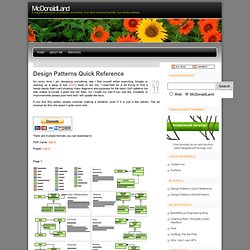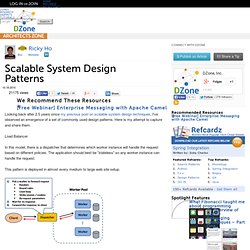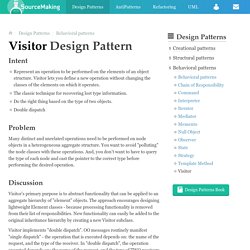

Mcdonaldland » Design Patterns Quick Reference. So every time I am designing something new I find myself either searching Google or opening up a gang of four (GoF) book to aid me.

I searched for a bit trying to find a handy-dandy flash card showing class diagrams and purposes for the basic GoF patterns but was unable to locate a good one (for free). So I made my own.If you see any mistakes or improvements please post here and I will update the docs. If you find this useful, please consider making a donation, even if it is just a few dollars.
The ad revenue for this site doesn’t quite cover rent… There are multiple formats you can download in: PDF Cards: Get it! Poster: Get it! Page 1: Page 2: Enjoy! Scalable System Design Patterns. Looking back after 2.5 years since my previous post on scalable system design techniques, I've observed an emergence of a set of commonly used design patterns.

Here is my attempt to capture and share them. Load Balancer In this model, there is a dispatcher that determines which worker instance will handle the request based on different policies. The application should best be "stateless" so any worker instance can handle the request. This pattern is deployed in almost every medium to large web site setup. Scatter and Gather In this model, the dispatcher multicast the request to all workers of the pool. This pattern is used in Search engines like Yahoo, Google to handle user's keyword search request ... etc. Result Cache In this model, the dispatcher will first lookup if the request has been made before and try to find the previous result to return, in order to save the actual execution. Design Patterns Explained With Java and Uml2 2008 - Internet &am.
Pratiquer le design-pattern Observer en 15 min. Les design-pattern (ou motifs de conception) réalisent le principe de ne pas réinventer la roue en capitalisant les expériences.

En effet, un design-pattern décrit à la fois : Les situations de conception que l'on rencontre trop souvent dans le développement de logicielsLes solutions types (abstraites ou de haut niveau) identifiées pour ces problèmes (formelles ou non, indépendamment des langages objets)Les bénéfices d'utiliser ces solutions dans le développement de logiciels. Les design-pattern offrent donc une description complète des problèmes répétitifs et les solutions abstraites retenues en expliquant les conséquences à l'usage.
Cette description reste indépendante du langage objet et voire du métier développement de logiciels. Néanmoins, notons que les design ne sont pas des briques logicielles. Le design-pattern observer Situation: Le besoin consiste à notifier tout changement de l'état d'un objet aux objets dépendants (pour rester simple, la notification est unidirectionnelle). Design Patterns. In software engineering, a design pattern is a general repeatable solution to a commonly occurring problem in software design. A design pattern isn't a finished design that can be transformed directly into code. It is a description or template for how to solve a problem that can be used in many different situations.
Uses of Design Patterns Design patterns can speed up the development process by providing tested, proven development paradigms. Effective software design requires considering issues that may not become visible until later in the implementation. Often, people only understand how to apply certain software design techniques to certain problems. In addition, patterns allow developers to communicate using well-known, well understood names for software interactions.
AntiPatterns. What Is an AntiPattern?

AntiPatterns, like their design pattern counterparts, define an industry vocabulary for the common defective processes and implementations within organizations. A higher-level vocabulary simplifies communication between software practitioners and enables concise description of higher-level concepts. An AntiPattern is a literary form that describes a commonly occurring solution to a problem that generates decidedly negative consequences. The AntiPattern may be the result of a manager or developer not knowing any better, not having sufficient knowledge or experience in solving a particular type of problem, or having applied a perfectly good pattern in the wrong context.
AntiPatterns provide real-world experience in recognizing recurring problems in the software industry and provide a detailed remedy for the most common predicaments. Furthermore, AntiPatterns present a detailed plan for reversing these underlying causes and implementing productive solutions. Refactoring. Visitor Design Pattern. Intent Represent an operation to be performed on the elements of an object structure.

Visitor lets you define a new operation without changing the classes of the elements on which it operates.The classic technique for recovering lost type information.Do the right thing based on the type of two objects.Double dispatch Problem Many distinct and unrelated operations need to be performed on node objects in a heterogeneous aggregate structure. You want to avoid "polluting" the node classes with these operations. Discussion Visitor's primary purpose is to abstract functionality that can be applied to an aggregate hierarchy of "element" objects. Visitor implements "double dispatch".
The implementation proceeds as follows. Each operation to be supported is modelled with a concrete derived class of the Visitor hierarchy. Everything for "elements" and "visitors" is now set-up. The accept() method causes flow of control to find the correct Element subclass. Structure Example Check list Rules of thumb.